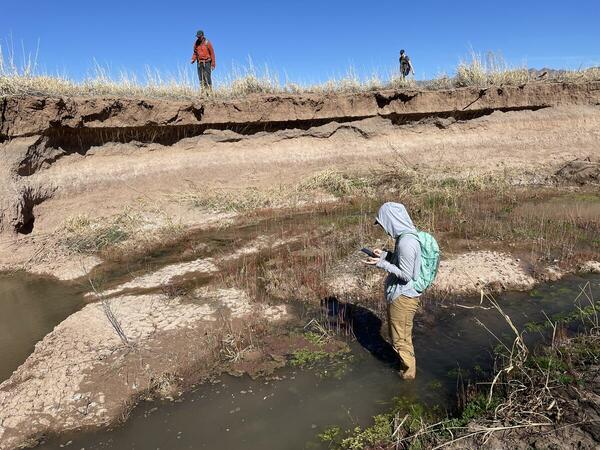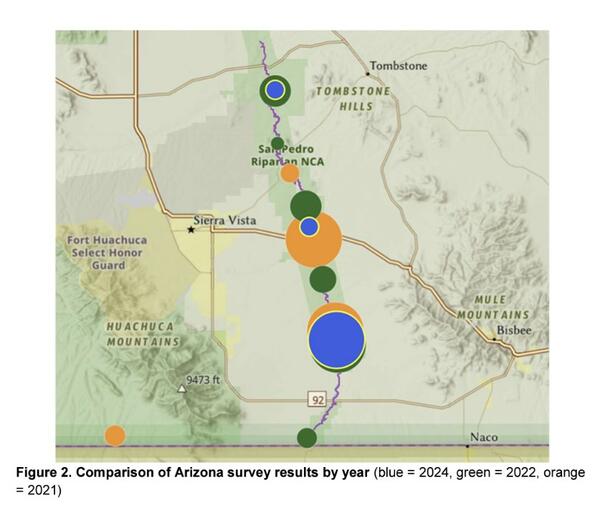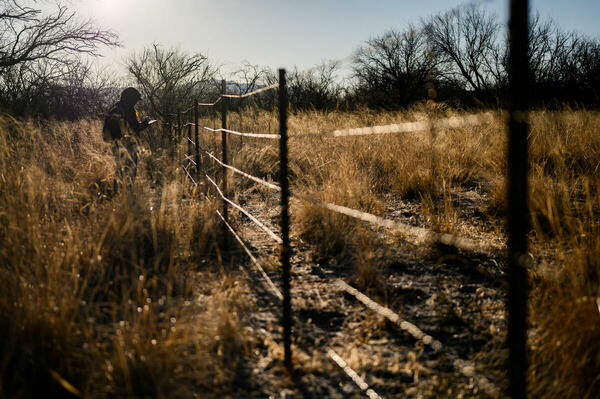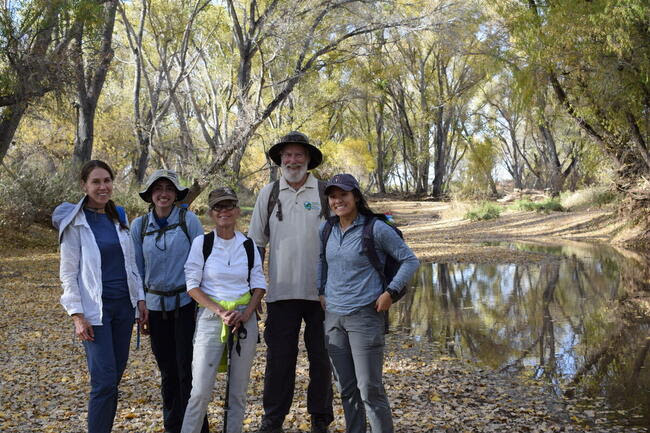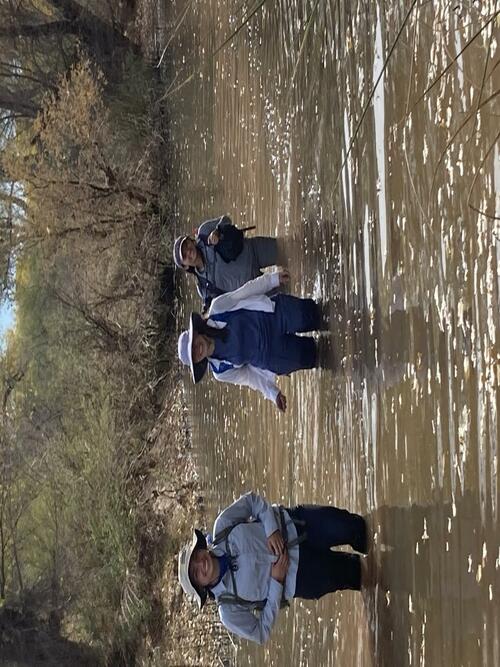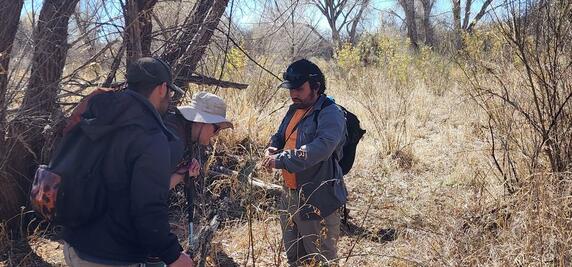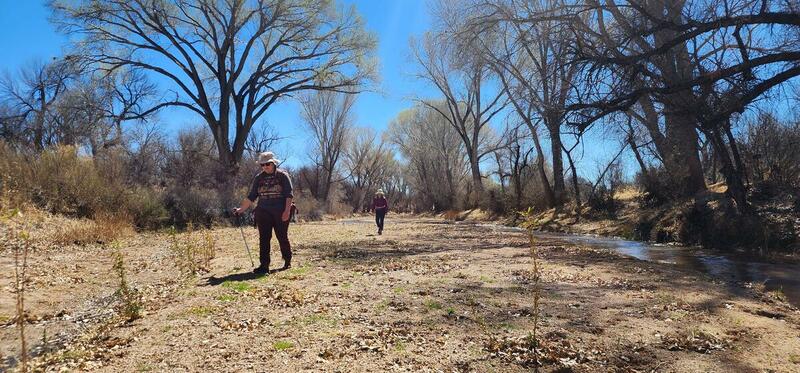
Volunteers hike through flowing rivers and dry riverbeds alike during the 2024 Beaver Survey.
Reviving a Keystone Species: Results from the 2024 Bi-National Beaver Survey
Read the full 2024 Bi-National Beaver Survey report here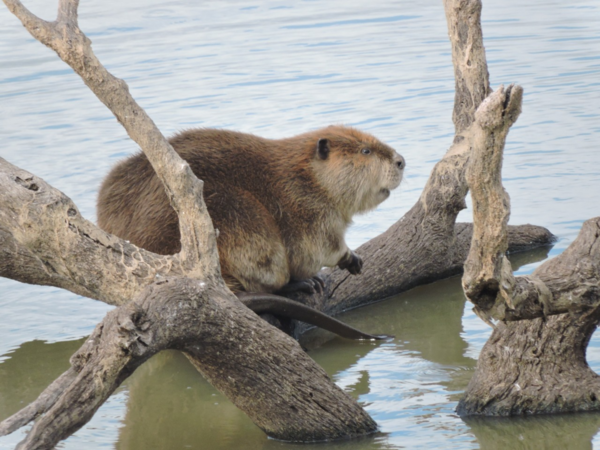
Introduction
Beavers, once a keystone species in the rivers of southeastern Arizona, play a crucial role in maintaining watershed health. However, due to over-trapping in the 1800s, they were extirpated from the region. In an effort to revive the species and restore the ecosystem services they provide, the Bureau of Land Management reintroduced beavers to the San Pedro River in 1999 and 2000.
Since 2020, Watershed Management Group and its partners have been monitoring the beaver population through annual bi-national surveys.
Survey Methods
In March 2024, WMG, along with community science volunteers and partner organizations, conducted the third annual bi-national beaver survey along the San Pedro River.
Over 75 dedicated volunteers and staff members hiked along 38 miles of the river within the San Pedro Riparian National Conservation Area (SPRNCA) in Arizona, recording evidence of beaver activity such as dams, lodges, tracks, and tree chews. The survey was planned to extend into Sonora, Mexico, but had to be postponed due to security concerns.
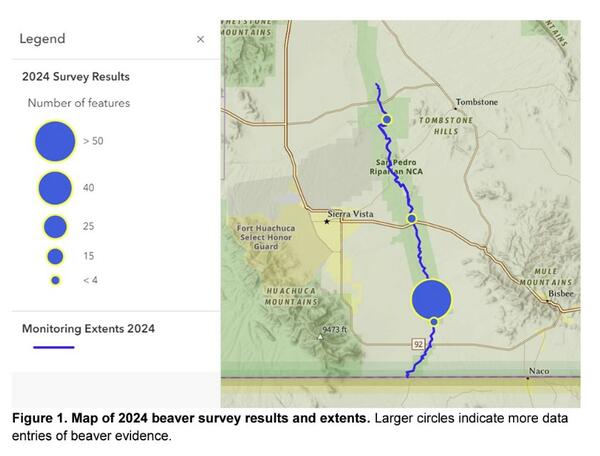
Key Findings
- Population Estimate: The survey results estimate a population of approximately 11-14 beavers along the San Pedro River in the U.S., a slight decrease from the 2022 estimate of 13-17 beavers.
- Beaver Activity: Volunteers recorded 174 beaver-related data entries, identifying five clusters of activity. Two of these clusters were large enough to be considered active family groups, while the remaining clusters indicated roaming beavers.
- Vegetation Impact: Beavers most frequently chewed willow trees in 2024, a shift from their preference for cottonwood in 2022.
Discussion
The beaver population in southern Arizona has declined from a peak of over 100 beavers around 2010.
The declining trend in the beaver population is concerning, as the species plays a vital role in the health of the river ecosystem. Potential factors contributing to this decline include fluctuating water levels during recent monsoon seasons and increased predation by local species such as mountain lions.
Addressing these challenges requires continued monitoring, research, and community engagement.
Conservation Efforts
Protecting beaver habitat is essential for the long-term survival of the species in the region. One key issue identified during the survey was the presence of cattle within the SPRNCA, which can degrade river banks and trample young vegetation.
WMG is working with landowners, ranchers, and the Bureau of Land Management to improve fencing and prevent cattle from accessing the riparian areas, ensuring a suitable habitat for beavers.
Conclusion
The 2024 bi-national beaver survey, made possible by the hard work of community science volunteers and partner organizations, provides valuable insights into the current state of the beaver population along the San Pedro River. While the results indicate a slight decline, they also underscore the importance of continued monitoring and conservation efforts. By working together to protect and restore beaver habitat, we can help ensure the long-term health of the river ecosystem.
Get Involved
WMG's "Release the Beavers" campaign aims to advocate for beaver reintroduction, monitor population health, and restore creeks and rivers through the use of beavers as a natural solution.
In an exciting development, WMG has been leading the charge for the reintroduction of beavers into Ciénega Creek, a vision that's now on the brink of realization.
Through years of advocacy and rigorous groundwork, WMG and its coalition of local and international partners have reached a pivotal milestone: all agency Environmental Assessments are complete, and the Bureau of Land Management and AZ Game and Fish are planning to reintroduce beavers by the end of 2025.
Or, in other words...
The beavers are coming, the beavers are coming!
Stay up to date with our Release the Beavers campaign and help with future restoration efforts by joining the River Run Network.
Acknowledgments
WMG extends its gratitude to the dedicated community science volunteers, partner organizations, and funding partners, including The Nature Conservancy and National Park Service Southwest Border Protection Program, for their invaluable support in making the 2024 bi-national beaver survey a success.
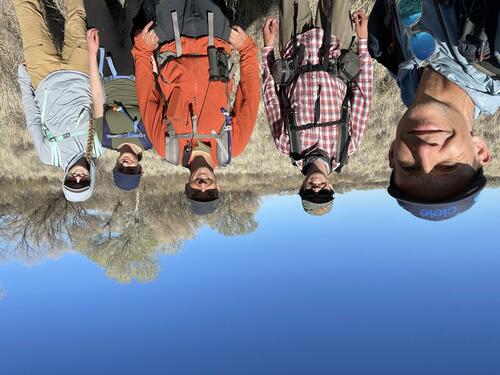
Special thanks to The Nature Conservancy, Mike Foster, Steve Merkley, Profauna, CONANP, the National Park Service and all of the community volunteers for their contributions to this effort.
And, last but not least, shout out to the hard work and dedication of the study's co-authors, WMG’s own Conservation Ecology Intern, Paul Strong and Sr. Program Director, Catlow Shipek.
Read the full 2024 Beaver Survey results here
Land and Water Acknowledgement
Watershed Management Group acknowledges that we live, learn, work, and engage with community on the ancestral lands of the Hohokam and Sobaipuri, and those of the Apache, Pascua Yaqui, and Tohono O'odham, whose relationship with this land continues to this day. We acknowledge that water in the Sonoran Desert is of great spiritual, physical, and ecological significance to be protected, cherished, and celebrated.
We invite you to learn more about the indigenous communities, the lands we inhabit, and the history of the land and its people by visiting: www.native-land.ca
Other articles you might like:
-
The 3rd Annual Binational Beaver Survey
-
Pedaling For Progress: The PFAS Problem
-
7th Annual Flow & Feast

